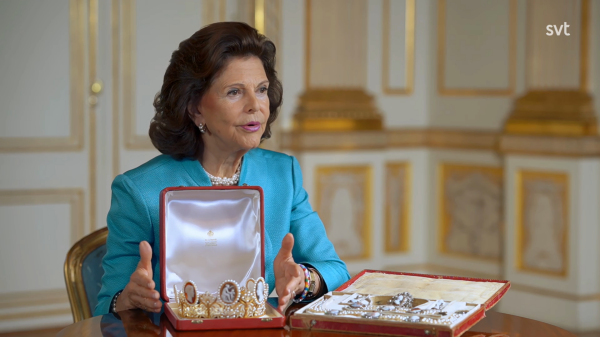 |
| SVT |
Earlier this month, we talked briefly about a fantastic new royal jewelry documentary, Kungliga Smycken, coming to Sweden’s SVT. Both episodes have now aired, and they’re packed with wonderful interviews, rare archival footage, insights from jewelers and historians, and spectacular views of the Bernadotte jewels. We also learned a few new things, and today’s post hits some of those highlights.
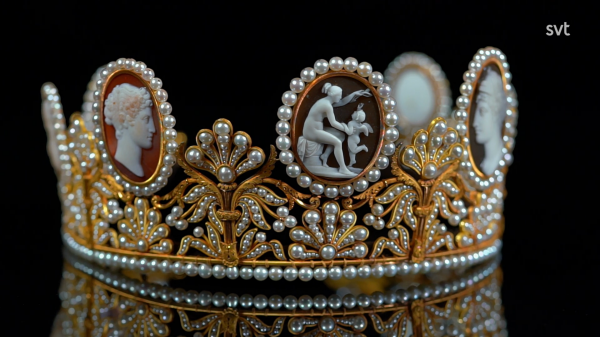 |
| SVT |
The documentary confirms that the cameos were given to Empress Josephine by Napoleon I. The tiara was made by Marie-Étienne Nitot, Napoleon’s court jeweler, in 1809. During filming, it was discovered that some of the cameos in the tiara are signed. The front cameo, which depicts Venus and Cupid, was made by Giuseppe Girometti, and the cameo depicting Dionysus and Cupid was made by Vincenzo Catenacci. Filippo Rega also contributed to the set. The brooch’s cameo features a depiction of Napoleon himself. The film takes the same view as Vincent Meylan regarding the journey of the cameos, suggesting that they were inherited by Prince Eugene, Duke of Leuchtenberg, when his mother died in 1814.
The royal ladies also revealed some of their personal feelings about the cameos. Crown Princess Victoria notes that the tiara is very fragile, and that she has “a little extra respect” for the cameos and their history. Queen Silvia adds that she doesn’t like to travel with the cameos. She also speaks about her decision to wear the tiara on her wedding day in 1976. She reveals that it was King Carl XVI Gustaf who suggested that she use it as her bridal diadem. Silvia agreed partly because she liked the fact that it had previously been worn as a wedding tiara by Princess Birgitta and Princess Desiree. Her sisters-in-law, especially Princess Christina, helped teach Silvia about the history and importance of the Bernadotte jewelry, as did the king’s aunt, Queen Ingrid of Denmark.
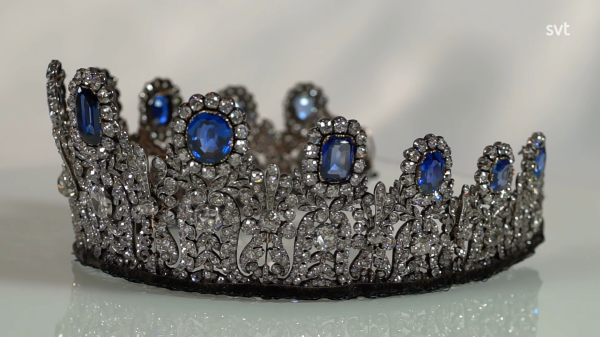 |
| SVT |
The documentary features work from historian Claudia Thomé Witte, who has helped to discover the precise provenance of the sapphires. They were a gift from Empress Josephine to her daughter-in-law, Princess Augusta, Duchess of Leuchtenberg; the sapphires, presented to Augusta between December 1810 and February 1811, were a gift to mark the birth of Augusta’s son, Prince Auguste. The film also confirms that the diadem used to be able to be worn with a set of pearls. Those pearls still exist, and have been used in other pieces of jewelry (including earrings), but the sapphires are now permanently affixed to the tiara.
The original parure included earrings, which were disposed of by Victoria of Baden (who never wore earrings.) The current earrings were created using two of the set’s hairpins. Queen Silvia confirms that the sapphires are very easy to wear, especially as her hairdresser, Peter Hägelstam, developed a base for the tiara that allows it to be more comfortably secured to Silvia’s hair with pins. Silvia specifically mentions the sapphires as her personal favorite set of jewels from the Swedish vault.
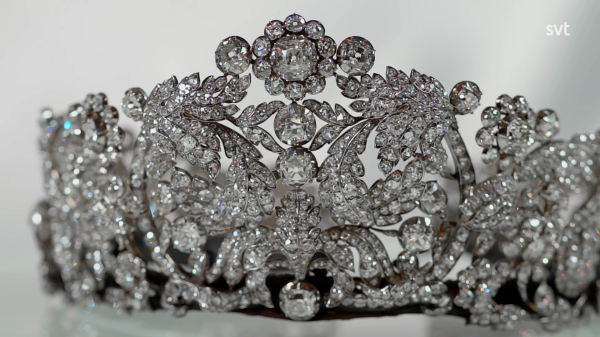 |
| SVT |
Art historian Göran Alm, who works closely with the Bernadotte collection, calls this tiara the most important piece of jewelry in the Swedish royal vault. He helps clear up the confusing description of the piece as a “coronation tiara” — it was never worn for a Swedish coronation, but a writer in the 1920s/1930s made the “coronation” claim with no historical evidence, and the description was subsequently repeated. Queen Silvia notes that the tiara is very heavy and difficult to wear and gives an entertaining description of her first official portrait session, which featured the diadem.
Historian Claudia Thomé Witte discusses the tiara’s origins in imperial Brazil. She confirms that Pedro I bought the diamonds used in the tiara from his children, who had inherited them from his first wife. He subsequently gave the diamonds to his second wife Princess Amelie of Leuchtenberg, as a wedding gift (in the form of a necklace) and, a year later, as an eighteenth-birthday gift. Witte also explains that Pedro used Amelie’s diamonds as backing for a loan he secured from a London bank; he used the money to finance a war against his brother, Miguel. The jewels were returned to Amelie after the war ended.
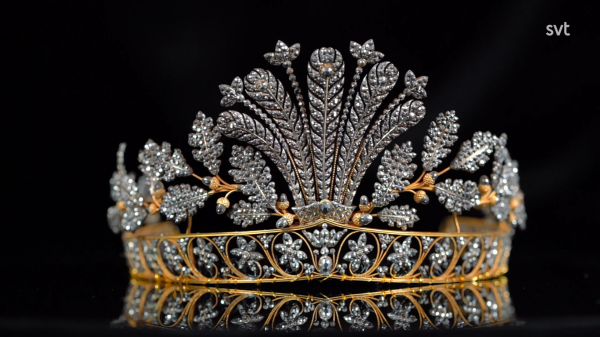 |
| SVT |
Turns out it wasn’t Queen Silvia who discovered this long-lost tiara! Instead, it was historian Göran Alm who found the tiara. It was hidden away in a storage room full of silver, and Alm happened upon it while working on an exhibit about King Carl XIV Johan. The documentary confirms that the tiara belonged to Hortense de Beauharnais, Empress Josephine’s daughter, who left the steel jewels to her niece, Princess Eugenie of Leuchtenberg. Eugenie left the steel suite to her sister, Empress Amelie of Brazil, who in turn bequeathed them to their final surviving sister, Queen Josefina of Sweden.
In the interviews, Crown Princess Victoria talks about her love for the tiara, but also its extreme fragility. She deliberately chooses to wear the tiara only for occasions that don’t involve lots of movement — where she can sit very still, not dance, etc. But she reiterates that she feels that it’s important to keep wearing the jewels when she can, because it means they are “still alive.”
Leave a Reply